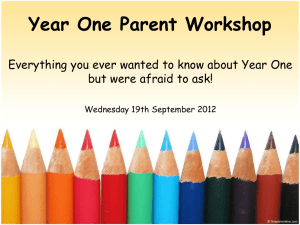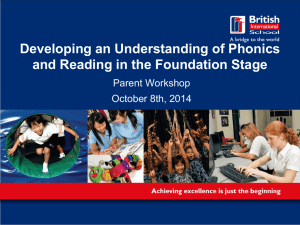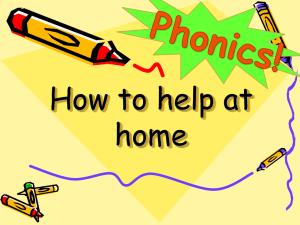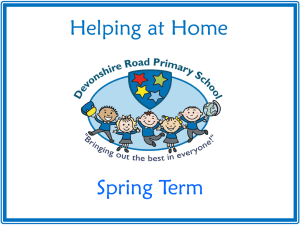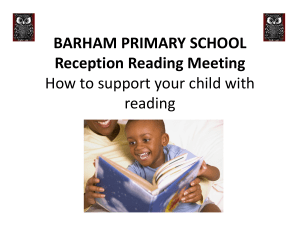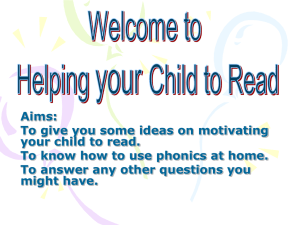File - HOLLAND HAVEN PRIMARY SCHOOL
advertisement
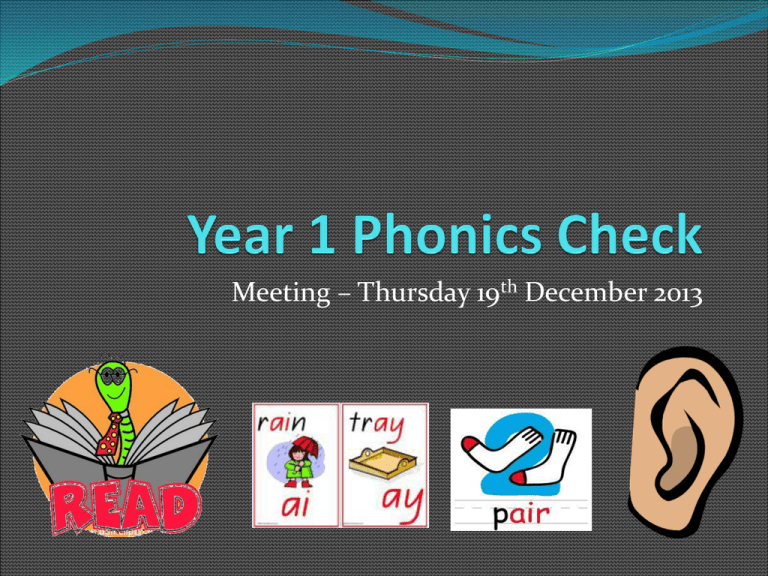
Meeting – Thursday 19th December 2013 What is the Year 1 Phonics Check? ‘The phonics screening check is a quick and easy check of your child’s phonics knowledge. It helps your school confirm whether your child has made the expected progress. Your child will sit with a teacher he or she knows and be asked to read 40 words aloud. Your child may have read some of the words before, while others will be completely new. The check normally takes just a few minutes to complete and there is no time limit. If your child is struggling, the teacher will stop the check. The check is carefully designed not to be stressful for your child.’ - DfE 2012 What are ‘non-words’? ‘The check will contain a mix of real words and ‘non-words’ (or ‘nonsense words’). Your child will be told before the check that there will be non-words that he or she will not have seen before. Many children will be familiar with this because many schools already use ‘non-words’ when they teach phonics. Non-words are important to include because words such as ‘vap’ or ‘jound’ are new to all children. Children cannot read the non-words by using their memory or vocabulary; they have to use their decoding skills. This is a fair way to assess their ability to decode.’ -DfE 2012 After the check ‘Your school should tell you about your child’s progress in phonics and how he or she has done in the screening check in the last half-term of Year 1. If your child has found the check difficult, your child’s school should also tell you what support they have put in place to help him or her improve. You might like to ask how you can support your child to take the next step in reading. All children are individuals and develop at different rates. The screening check ensures that teachers understand which children need extra help with phonic decoding.’ - DfE 2012 So what is phonics? ‘Phonics is a way of teaching children to read quickly and skilfully. They are taught how to: • recognise the sounds that each individual letter makes; • identify the sounds that different combinations of letters make - such as ‘sh’ or ‘oo’; and • blend these sounds together from left to right to make a word. Children can then use this knowledge to ‘de-code’ new words that they hear or see. This is the first important step in learning to read.’ -DfE 2012 Teaching Phonics at Holland Haven At Holland Haven phonics is taught through daily Letters & Sounds sessions. Pupils are taught from reception into Year 1 & 2. Where needed, phonics and spelling strategies are taught in KS2. There are 5 phases that children are taught, and children then progress onto Support for Spelling and other phonics work as they progress through the school to their needs and abilities. So how do I help my child? Hear your child read every day and, if they struggle with a word, model sounding it out. This is called a strategy check. The child will then have the skills to decode (sound out) the word and blend it (put it back) together to create the new word. • Encourage your child to ‘sound out’ when reading or writing. Focusing particularly on spotting more unusual sound patterns. Eg Digraph- 2 letters making one sound cow Trigraphs- 3 letters making one sound night Split digraphs- 2 vowels with a consonant inbetween. Use to be known as the magic e! spine - i_e Play games The children love to play games with focus sounds. Buried treasure shows real words and non-words which is perfect practice. http://www.phonicsplay.co.uk/BuriedTreasure2.html There are other games, like Picnic On Pluto which do the same type of game to practice real and non-words. Other suitable games http://www.familylearning.org.uk/phonics_games.ht ml www.bbc.co.uk/cbeebies/alphablocks/ www.ictgames.com/dinosaurEggs_phonics/index.htm l http://www.topmarks.co.uk/Interactive.aspx?cat=40 http://www.letters-and-sounds.com/ Ideas from the Department for Education (2012) Ask your child’s class teacher about the school’s approach to phonics and how you can reinforce this at home. For example, the teacher will be able to tell you which letters and sounds the class is covering in lessons each week. You can then highlight these sounds when you read with your child. Teaching how sounds match with letters is likely to start with individual letters such as ‘s’, ‘a’ and ‘t’ and then will move on to two-letter sounds such as ‘ee’, ‘ch’ and ‘ck’. With all books, encourage your child to ‘sound out’ unfamiliar words and then blend the sounds together from left to right rather than looking at the pictures to guess. Once your child has read an unfamiliar word you can talk about what it means and help him or her to follow the story. Your child’s teacher will also be able to suggest books with the right level of phonics for your child. These books are often called ‘decodable readers’ because the story is written with words made up of the letters your child has learnt. Your child will be able to work out new words from their letters and sounds, rather than just guessing. Try to make time to read with your child every day. Grandparents and older brothers or sisters can help, too. Encourage your child to blend the sounds all the way through a word. Word games like ‘I-spy’ can also be an enjoyable way of teaching children about sounds and letters. You can also encourage your child to read words from your shopping list or road signs to practise phonics. Mr Thorne Mr Thorne is a Year 2 teacher who is widely known for his Letters and Sounds resources and activities with children. Here he teachers how to pronounce all of the alphabet phonemes. http://www.mrthorne.com/44phonemes/ This is the correct way of sounding out- please practice with your child. How to segment and blend cat = c – a – t run = r – u – n black = b – l – a – ck play = p – l – ay light = l – igh – t clown = c – l – ow – n The clown went to play with the black cat. Spelling families So what will my child see in the Phonics Test? http://www.education.gov.uk/schools/teachingandlearni ng/assessment/keystage1/a00200415/phonics Here is the teacher’s training video which will shown you some kinds of responses from the pilot. Examples Before the test begins, the teacher will explain about how to spot real words and no-words (non-words have an alien picture by them). They will discuss the strategy that could be used to sound out. Here is the practice sheet from 2012 that the children would have been introduced to. Other words from 2012 test stin proom sarps thend chip jazz farm thorn • • • • • • • • stop truck jump lords kigh girst baim yune • • • • • • • • flods groiks strom splaw fair flute goat shine • • • • • • • • crept shrubs scrap stroke index turnip waiting portrait fot keb gan ulp poth shan veen quorg drap flarm lect voisk Words from 2013 test • • • • • • • • thin peck torn cheek trap snarl milk moist • • • • • • • • quigh herks jorb zale bluns skarld splot strabe • • • • • • • • • • • • toy spike fuel name props spoilt scram strike panic second tantrum reaching The lowdown on the test All questions taken from the DfE website (2012). When does it happen? Schools will be able to administer the check at any time that suits them during the week of the 16th to the 20th June 2014. If a child is absent during that week, the school can administer the check up until Friday 27th June 2014. How long does the check take? Every child is different, but in the pilot most children took between four and nine minutes to complete the assessment. All questions taken from the DfE website (2012). What was the threshold for the standard in the pilot? The threshold in 2012 was 32 words out of 40. This standard was set by Year 1 teachers following a recognised standard setting procedure. What skills do children need to meet the standard of the phonics screening check? All children need to be able to identify sounds associated with different letters, and letter combinations, and then blend these sounds together to correctly say the word on the page. The same skill is needed whether the word is a real word or a nonword. The words gradually get harder through the check as the combinations of letters become more complicated. As long as the child has said 32 out of the 40 words correctly, they will be considered to have met the standard. All questions taken from the DfE website (2012). Will the standard be the same in June 2014? The threshold for 2014 will be included in the screening check materials which will remain secure until the start of the check week (16 June 2014). The threshold will ensure standards are maintained over time What happens if a child does not meet the standard? The screening check will identify children who have phonic decoding skills below the level expected for the end of Year 1 and who therefore need extra help. Schools will be expected to provide extra help and children will then be able to retake the assessment in Year 2. All questions taken from the DfE website (2012). Why did so few children in the pilot achieve the required standard compared with the numbers of children achieving Level 2 by the end of Key Stage 1? The Government recognises that ambitions for the phonics check are more challenging than the current trajectory towards reading at the end of Year 2. But we make no apology for being ambitious about aiming for high standards in the teaching of reading. We believe that if children get the fundamental skill of reading using phonics right early on it will give them a flying start and allow them to move quickly to reading books for themselves and achieving even more in the future. Evidence from around the world shows that a systematic approach to the teaching of phonics gives children the best start in their reading. We recommend that some schools might like to consider their approach to teaching phonics, and make sure they are setting suitable high expectations for pupils’ progress in Year 1. Remember... Phonics is not the only thing needed to become a fluent reader. • Please continue to read with your child each night and encourage them to: • Sound out • Re-read to check it makes sense. • Use pictures for clues. • Ask questions about the book. • And most importantly ENJOY READING! Any questions?
